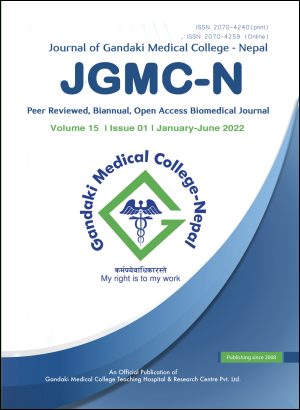Comparison of ultrasonography and computed tomography in detecting urolithiasis in a teaching hospital of Kaski district
DOI:
https://doi.org/10.3126/jgmcn.v15i1.42900Keywords:
Computed tomography, ultrasonography, urolithiasis, location, sideAbstract
Introduction: Urolithiasis is an increasing health problem worldwide including developing countries like Nepal. Ultrasonography and computed tomography of kidney, ureter and urinary bladder imaging modalities are used in detection of urolithiasis. This study was done to compare ultrasonography and computed tomography of kidney, ureter and urinary bladder findings for detection of urolithiasis.
Methods: A cross-sectional study was conducted in Department of Radiology, Gandaki Medical College, Pokhara, Nepal from July to October, 2021 after obtaining ethical clearance from Institutional Review Committee of Gandaki Medical College. Total 92 patients who had urolithiasis in computed tomography and had ultrasound report available within one week were selected for the study. Demographic data of patients, location and side of calculi were recorded. The findings of ultrasonography and computed tomography were then compared. Similarly, sensitivity and specificity of ultrasonography were calculated.
Results: Urolithiasis was more common in middle age groups i.e. 20 to 40 years (n= 57, 62.0%) and in males (n=56, 60.9%). Kidney was the commonest location detected by both ultrasonography (n=45, 48.9%) and computed tomography (n=44, 47.8%) with predominance in right side. Some of the calculi that were undetected by ultrasonography were easily confirmed by computed tomography in various locations. This was found to be statistically significant (p<0.05). The sensitivity and specificity of ultrasonography in compared to computed tomography was 83.7% and 100% respectively.
Conclusions: Ultrasonography has poor sensitivity and high specificity for detecting urolithiasis. Thus, computed tomography can be considered as better imaging modality as compared to ultrasonography for diagnosis of urolithiaisis.
Downloads
Downloads
Published
How to Cite
Issue
Section
License
Copyright (c) 2022 Nawaraj Paudel, Pujan Sharma, Bhoj Raj Sharma, Keshav Sharma, Santwana Parajuli, Krishna Timilsina

This work is licensed under a Creative Commons Attribution-NonCommercial 4.0 International License.
This license allows reusers to distribute, remix, adapt, and build upon the material in any medium or format for noncommercial purposes only, and only so long as attribution is given to the creator.




